The chip cherry mushroom (Leratiomyces ceres) is an interesting species. No one seems to know with certainty where it originated. It grows in mulch and has a worldwide distribution, but an unknown original source. It is not an extremely common species, but when it shows up, it’s hard to miss! Its cap is a bright cherry-red (hence the name!) and it fruits in big groupings.
This mushroom is most likely not native to most of America, but it has been showing up in the last few years across the country. It most likely came with imports of trees and mulch. It is more common in the Pacific Northwest, but it’s also been found in North Carolina. They also are native to or were spread to Europe, Australia, and New Zealand.
- Scientific Name: Leratiomyces ceres
- Common Names: Chip cherry, Redlead roundhead, Larrys
- Habitat: Mulch
- Edibility: Not edible
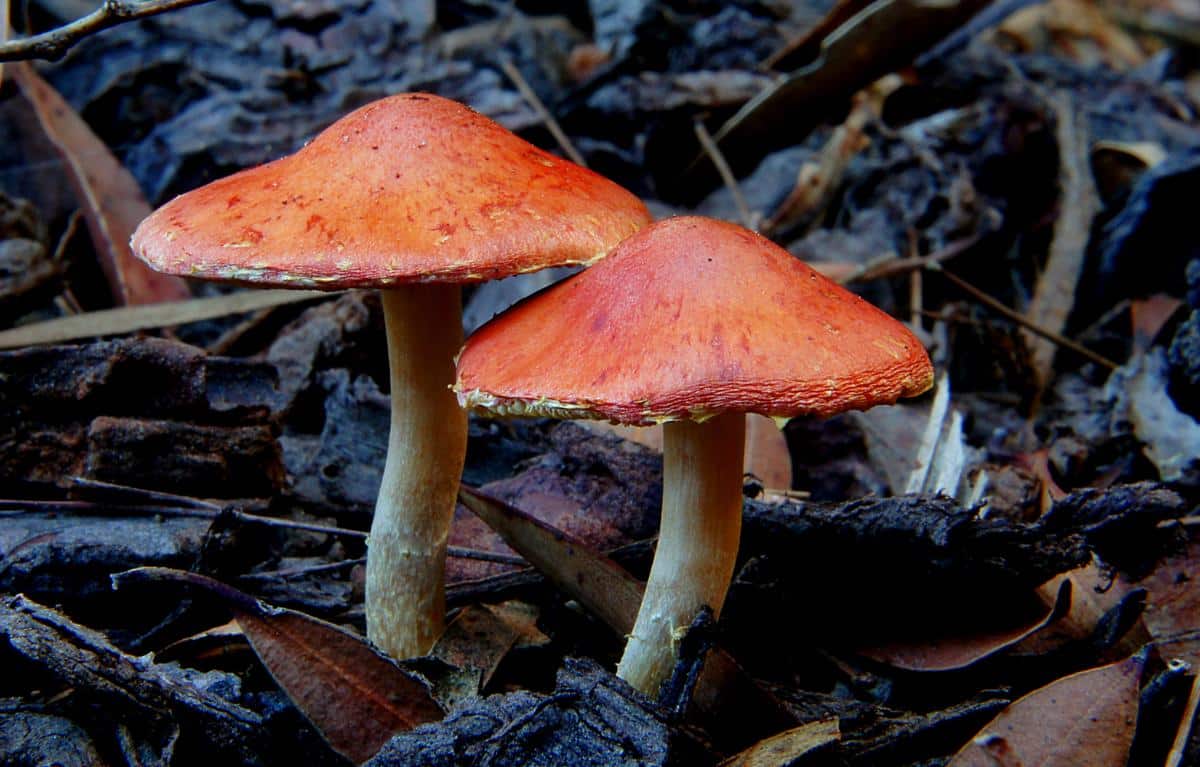
Jump to:
All About Chip Cherry Mushrooms
The chip cherry mushroom is in the family Strophariaceae (the same family as wine caps). It has had tons of name changes over the years. However, in 2008, DNA analysis determined that it should be Leratiomyces ceres.
Chip cherry mushrooms were first described in Melbourne, Australia, in 1888. They have been classified as Agaricus ceres, Psilocybe ceres, Hypholoma aurantiaca, Naematoloma aurantiaca, and others throughout their lifetime.
People call this mushroom chip cherry across North America and redlead roundhead in Europe. In Australia, they are called Larry’s (anyone know why?). The name chip cherry references its cherry-red color and its love for growing in wood chips. The specific name “ceres” also refers to the cap’s cherry red coloring.
Old field guides might list this species as Stropharia aurantiaca. This is the most recently used name before the 2008 renaming.
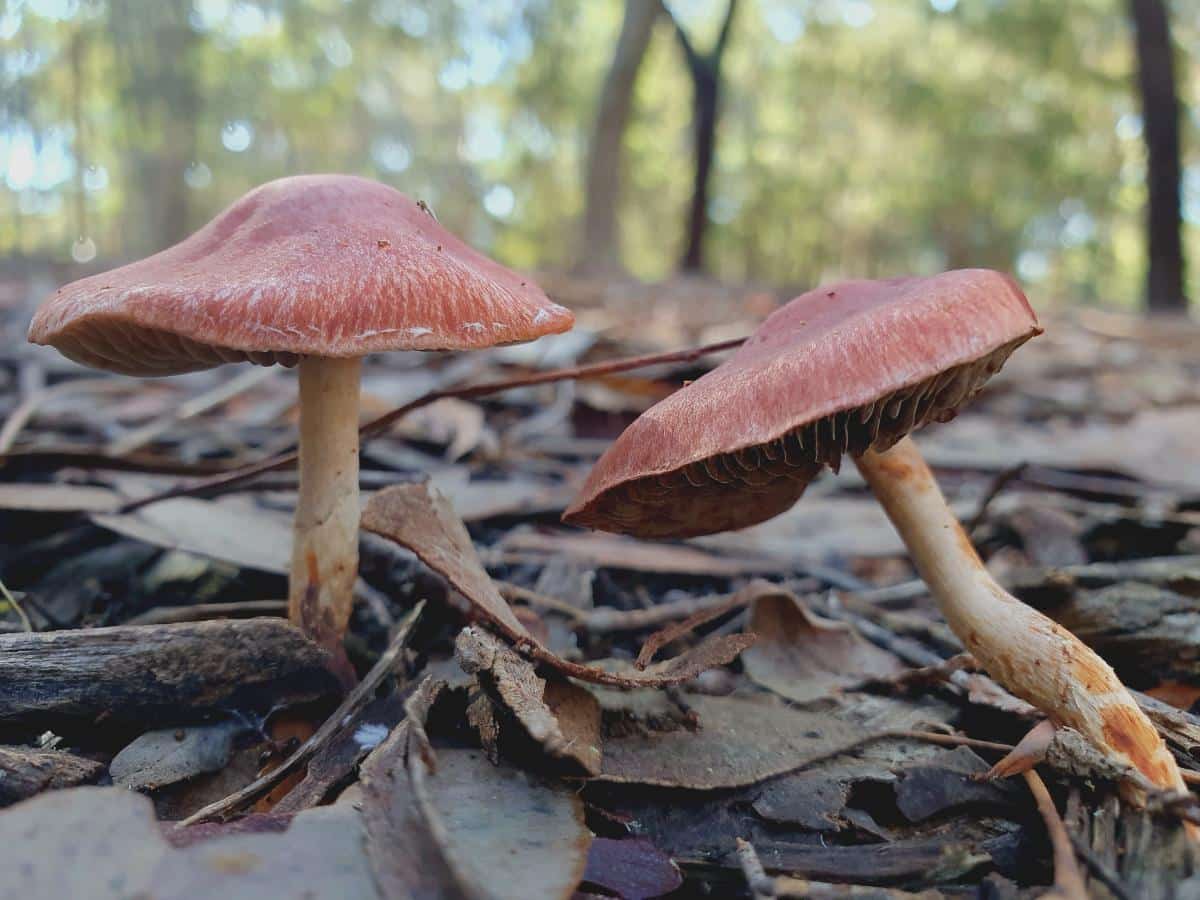
The Chip Cherry’s Journey
The chip cherry mushroom appeared on North America’s west coast sometime after 1951. It also made its way to Europe during the 1950s. The Netherlands, Belgium, and England recorded their first reliable sightings between 1953 and 1957. The fungus is now well-known in France, Germany, Austria, Italy, Spain, and Switzerland. It is still spreading, too. In 2020, the chip cherry mushroom was found in North Carolina for the first time.
Most experts believe this mushroom originated in Australia or New Zealand, since that is where it was first described in 1888.
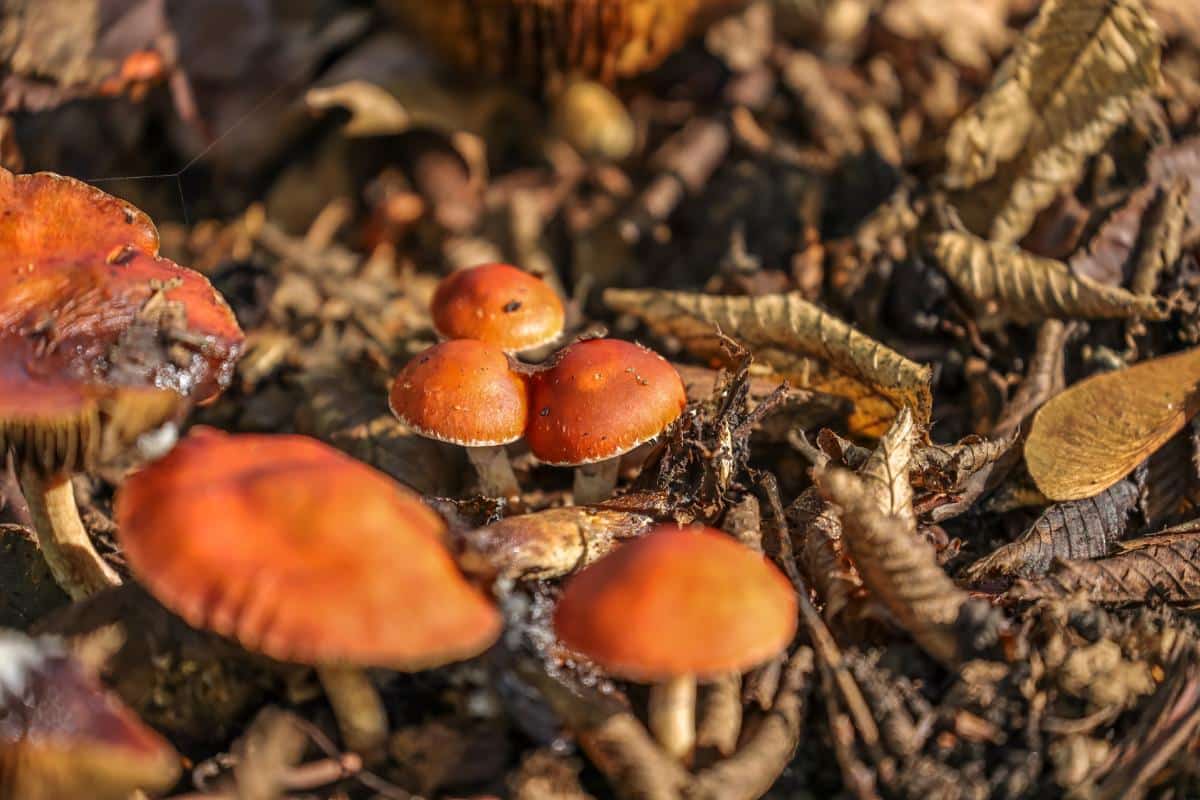
Chip cherry mushrooms expanded globally right alongside the rising popularity of wood mulching practices. The common belief is that the mushrooms came in through imported woodchip material. The mushroom spores hitched rides in mulch/woodchip transports and found perfect new homes in parks and gardens worldwide.
Another theory is that Leratiomyces ceres might naturally live in soil, but only shows itself when woodchip mulch creates the right conditions. The mushroom’s appearance in places like Kew Gardens (UK) hints that they might spread through natural spore dispersal rather than just hitching rides in commercial mulch.
It could be that both theories are correct. It can be natural in many areas and just not common. And, it could also hitch rides with woodchip transports and spread even further. Fungi are resourceful!
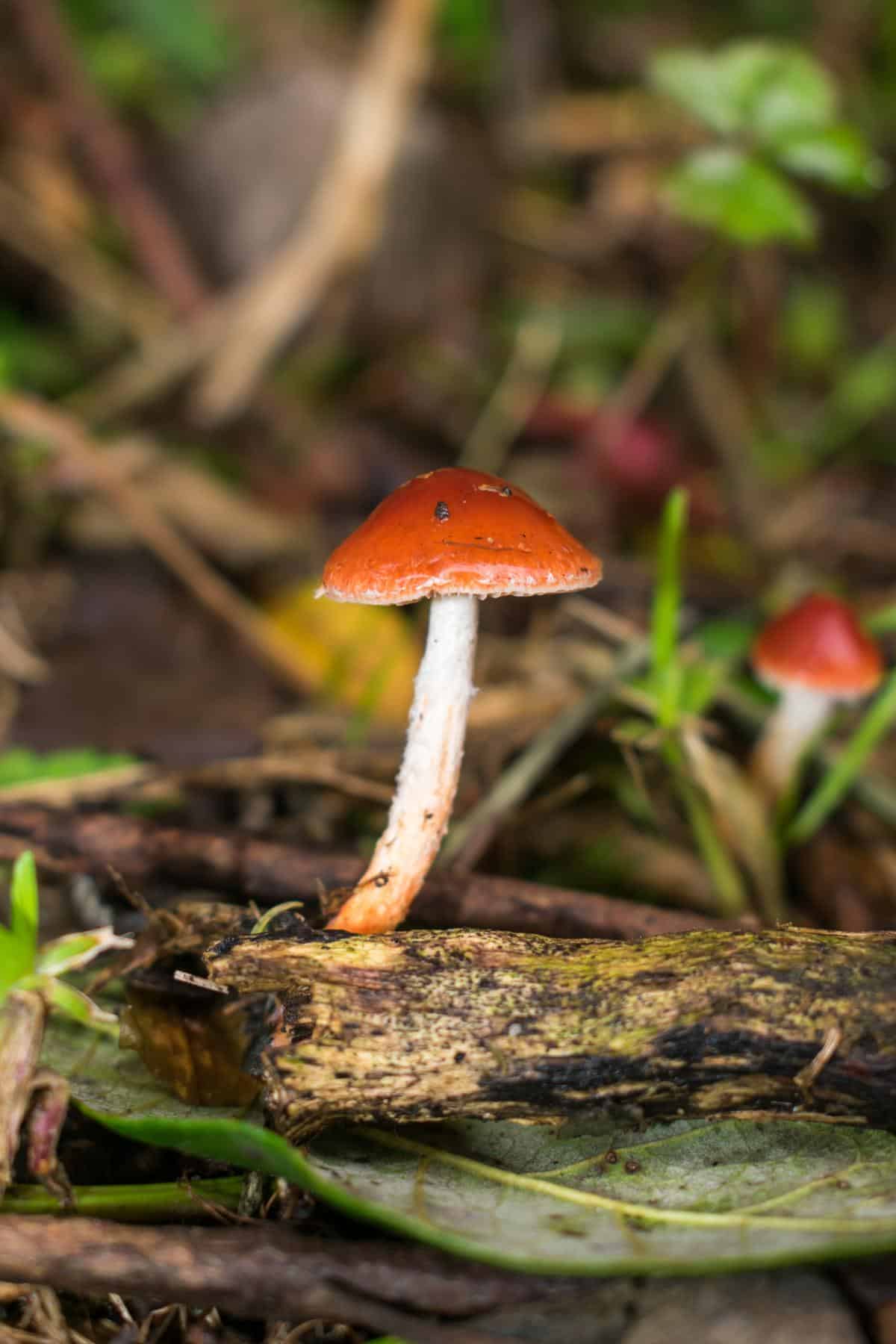
Chip Cherry Mushroom Identification Guide
Season
Chip cherry mushrooms fruit from early fall through late winter. These mushrooms don’t follow strict seasonal rules, though. They can fruit any month of the year if there’s enough moisture.
Habitat
These mushrooms grow on wood chips and in mulched areas. They love coarsely ground wood material, preferably that has only gone through one processing cycle. They grow in groups or clusters throughout gardens, parks, and landscaped areas with wood-based mulch. You might spot them in grassy areas, especially if there is needle litter and sawdust under pine trees. Some specimens grow directly from the soil without any visible wood debris nearby.
While they do grow from woodchips and sometimes from the ground, they never grow on trees or logs. They may grow singly but are more commonly found in vast groupings or scattered widely. Rarely is there just one.
The chip cherry mushroom is most commonly found on the West Coast, from California up to British Columbia. However, as evidenced by its ability to spread, it could potentially be found anywhere.
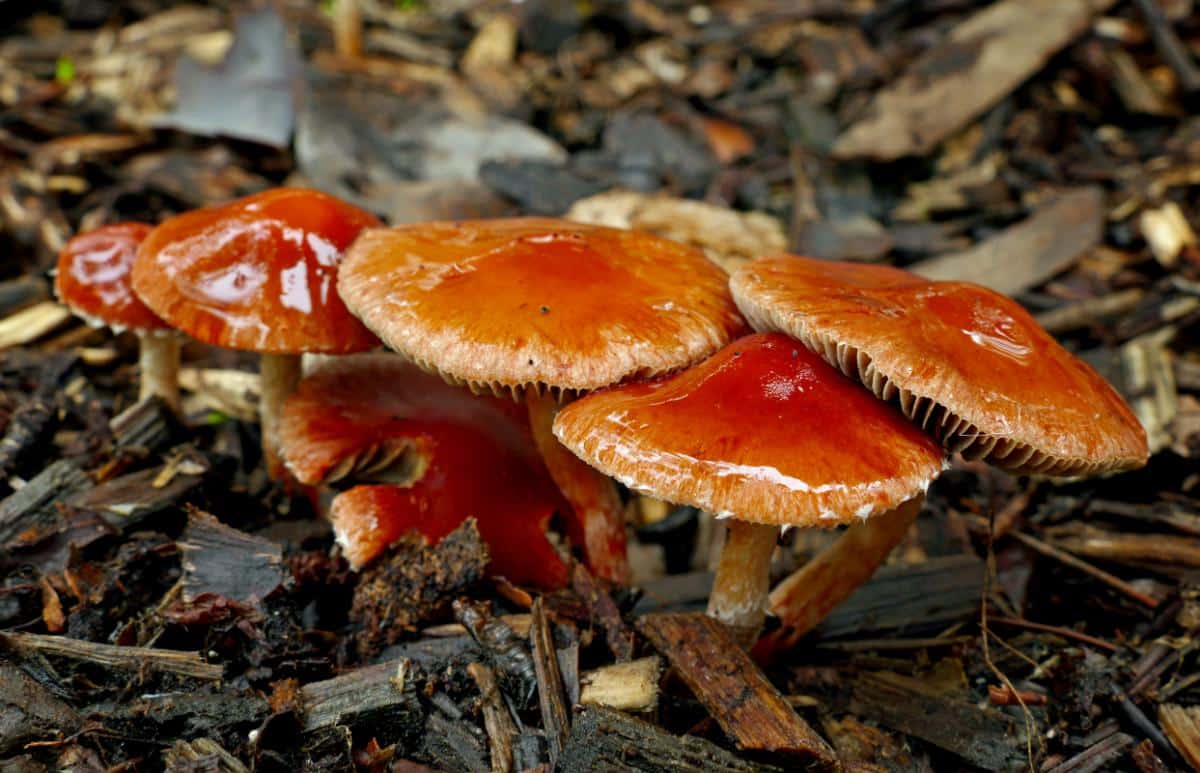
Identification
Cap
The cap ranges from vibrant reddish-orange to a brownish-orange that looks just like a cherry. The cap is 0.8-2.6 inches across. It starts out rounded and then flattens with age. The fresh caps might feel sticky and slimy when they’re wet, but they dry out quickly.
Younger mushrooms might have remnants of the partial veil hanging from the cap edge. These fragments usually disappear with age.
Gills
The gills connect to the stem of the mushroom with a distinct notch. The gills start pale yellow or grayish-brown, then change to purplish-gray or purple-black. The edges of the gills are usually lighter colored. They often have whitish to pale yellow tones. Red stains or spots might appear as the mushroom matures.
When the mushroom is young, the gills are covered by a white partial veil. This veil breaks as the mushroom grows to reveal the gills.
Stem
The stem is 1.2-2.4 inches long and starts out whitish to yellowish. With age, it stains orange-brown, particularly near its base. Around the upper part of the stem is a thin, membranous ring. The ring is a remnant of the partial veil the chip cherry had when it was young. The partial veil is connected to the stem where the ring now remains. With age, the ring may fall off or deteriorate.
The stem may be covered in very fine fibers or be smooth.
Flesh and Staining
Chip cherry mushroom’s flesh is thin and whitish. It might have pinkish tones under the cap’s surface. These mushrooms don’t change color when cut.
Odor and Taste
The smell and taste are mild.
Spore print
The spore print is dark purple-brown to purple-gray.
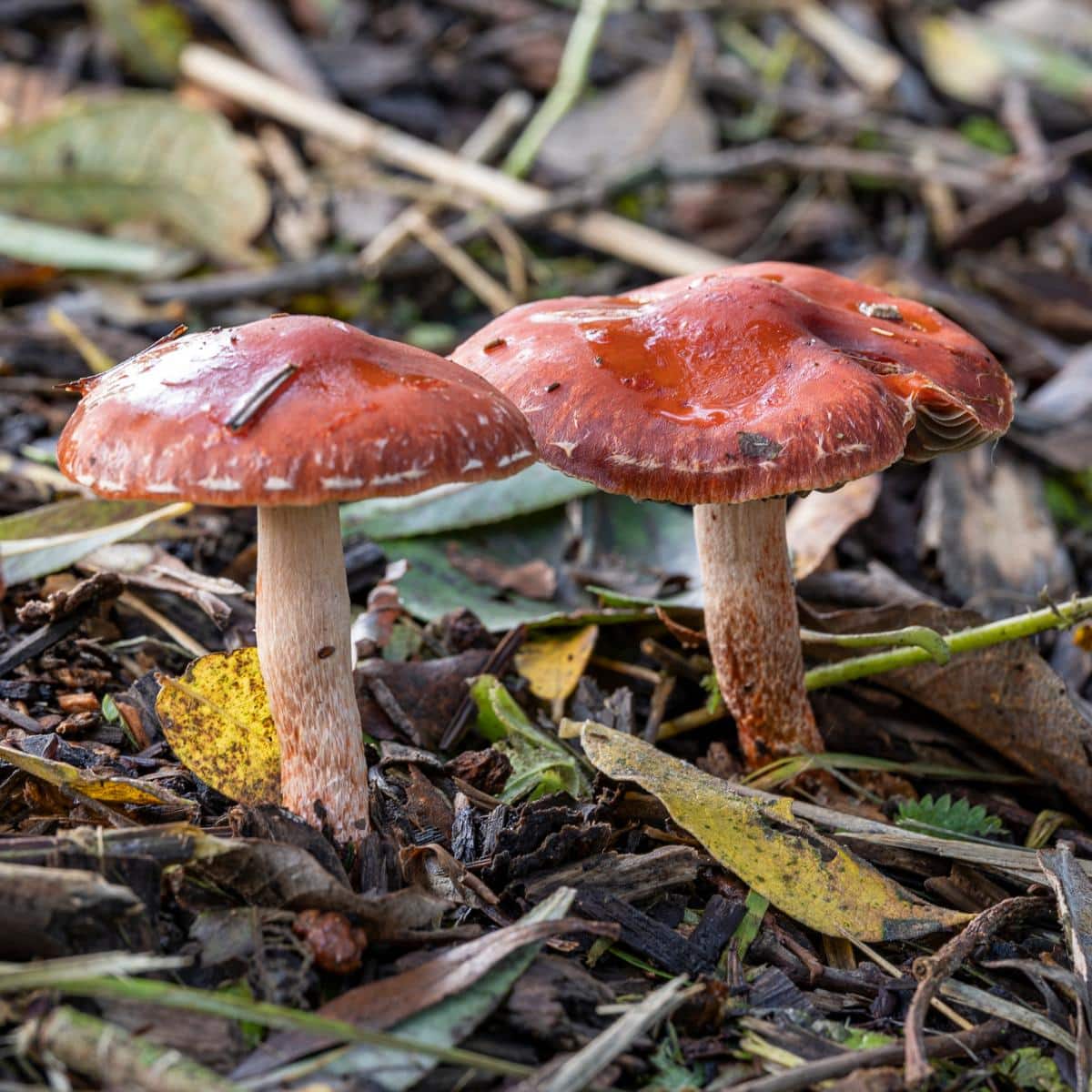


Chip Cherry Mushroom Lookalikes
Bloodred Webcap (Cortinarius sanguineus)
Both of these have distinctive red caps and are easily confused from the top. However, a closer can easily tell them apart. The bloodred webcap’s gills start out bright red and turn rusty reddish-brown. The chip cherry’s gills are much duller, yellowish to purple gray. If there is any confusion, you can do a spore print. The spore print of the bloodred webcap is rusty brown, not purple-brown like L. ceres.
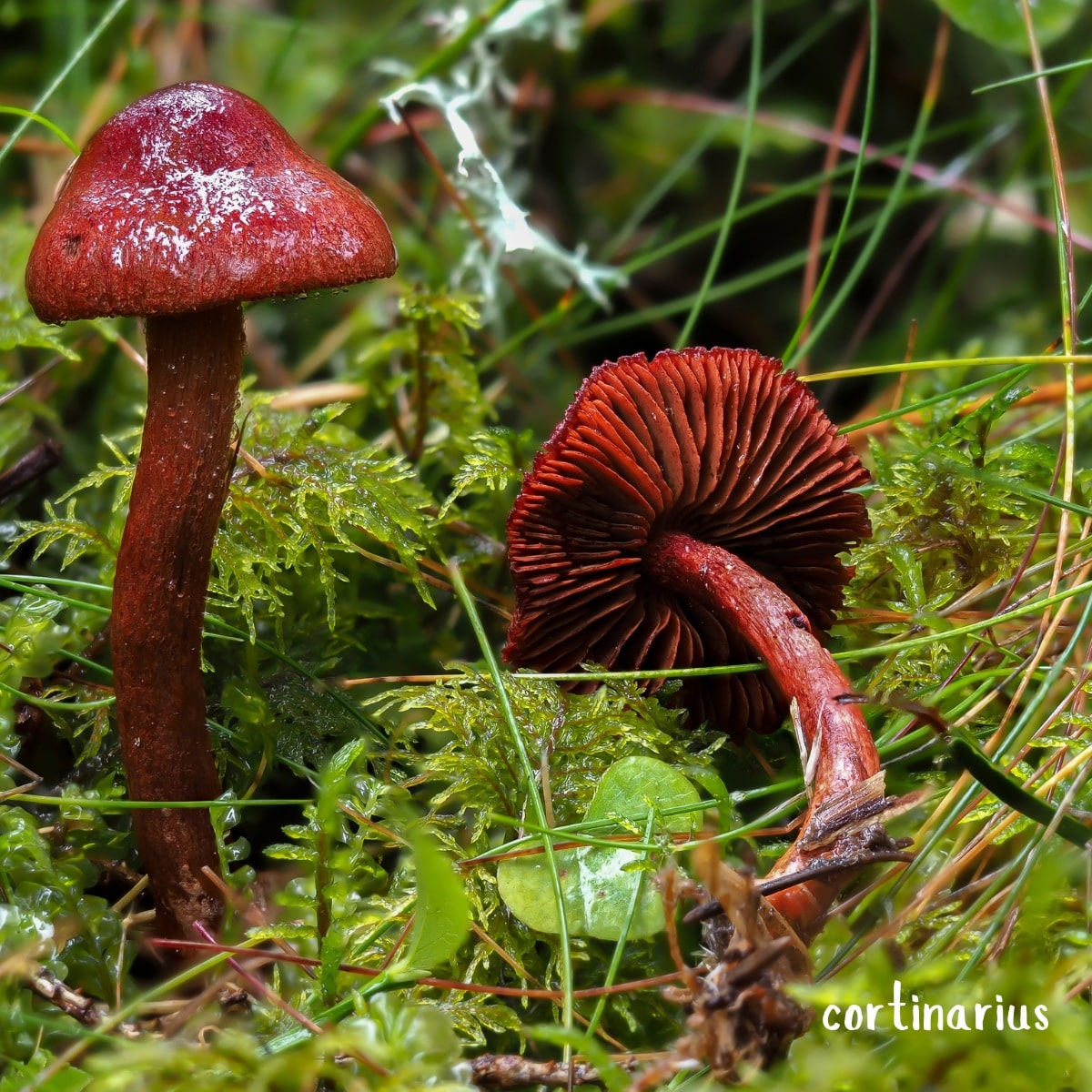
Wine Caps (Stropharia rugosoannulata)
Both of these mushrooms grow on woodchips in gardens and landscaped areas. And, they both have those beautiful purple-gray gills and reddish caps. The primary difference is cap color. Wine caps start out wine-red colored and age to a dull red to a bland brownish color. The chip cherry mushroom retains its reddish hue throughout its lifespan. It may turn more brownish orange, but it is never as dull as the wine cap.
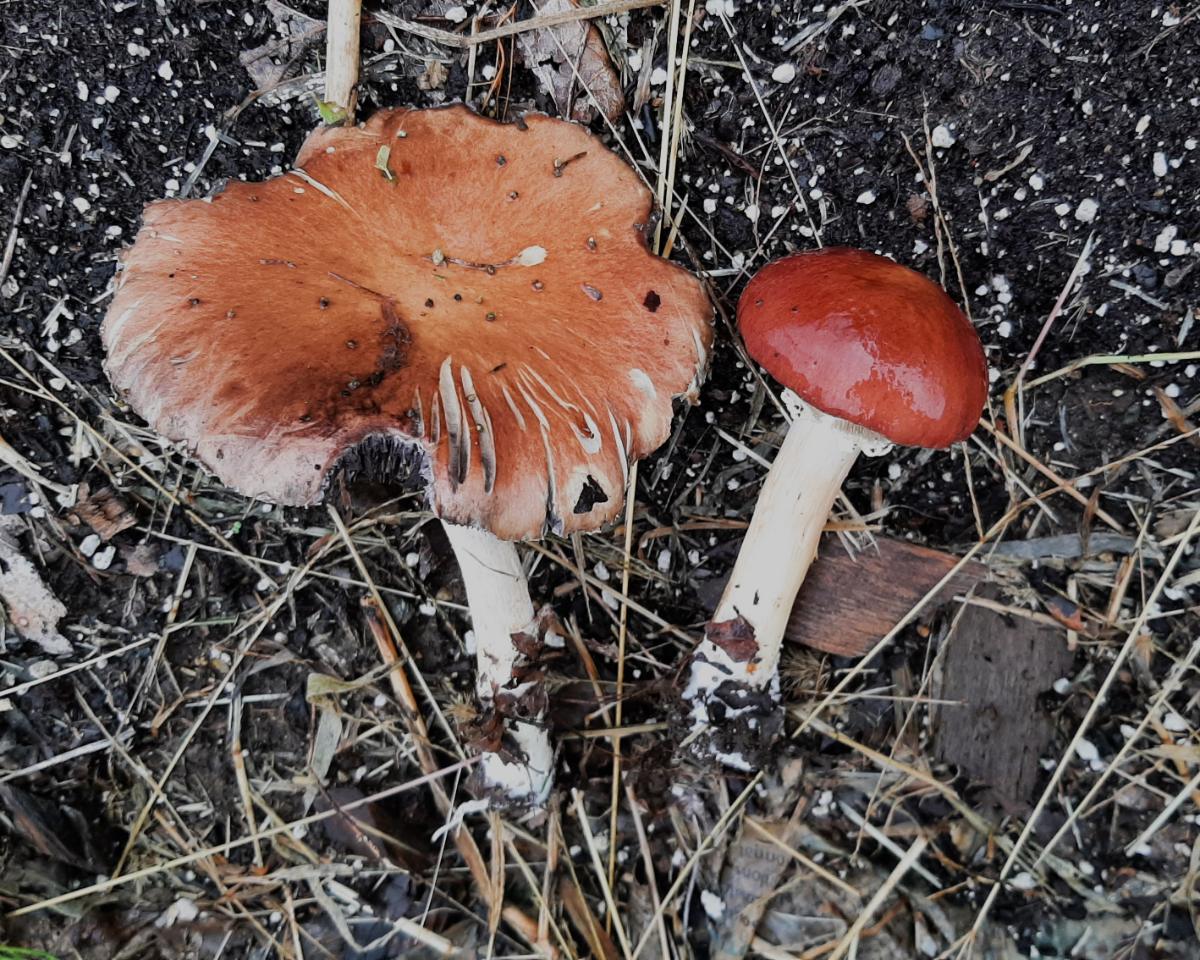
Leratiomyces squamosus var. thraustus
These two mushrooms look very much alike and have been confused for a long time. They both have orange-red caps, whitish stems, grey-purple gills, and grow from decomposing wood debris. There are two primary differences. L. squamosus has a more slender stem, and it has prominent scales below its stem ring. It also usually has a notably slimier cap surface. It also generally grows in hardwood and conifer forests, rather than in urban woodchips or gardens.
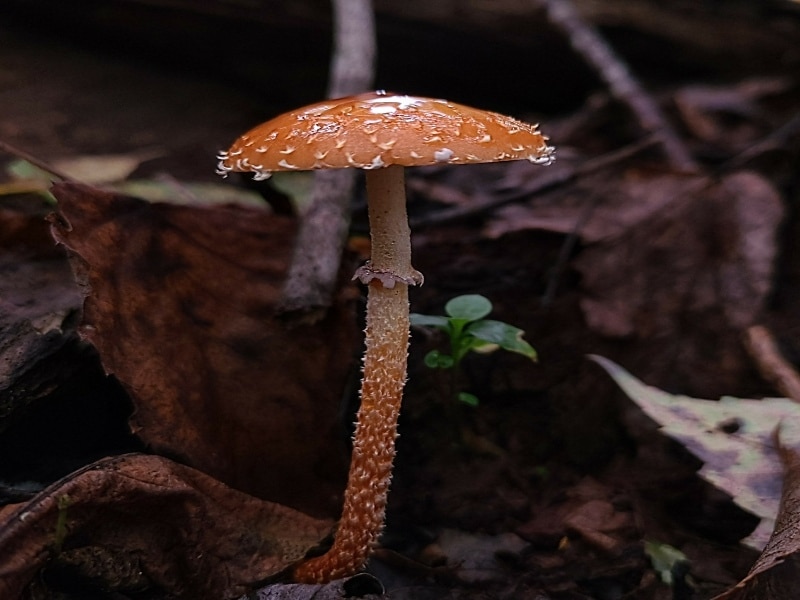
Mulch Fieldcap (Agrocybe putaminum)
The mulch fieldcap also grows in woodchips and landscaped areas, but is much duller than the chip cherry mushroom. Its cap is always brownish, and it does not have a ring around the upper stem. If there is confusion, do a sporeprint. The mulch fieldcap’s spore print is brown, while the chip cherry is purple-brown.
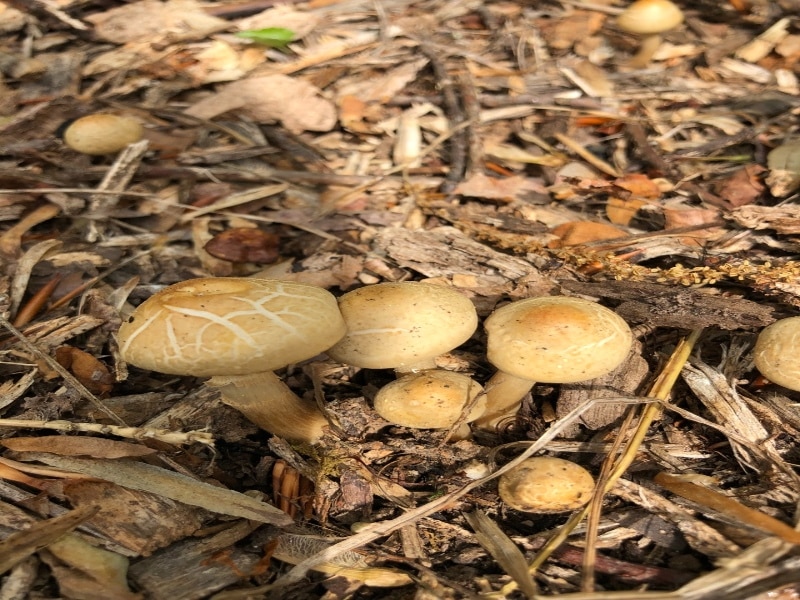
Scaly Rustgill (Gymnopilus sapineus)
The scaly rustgill has a yellowish to tawny or reddish-brown cap. When it is reddish, it can resemble the chip cherry mushroom. The easiest way to tell them apart is by what they are growing on. Scaly rustgills grow specifically on dead conifer wood. It doesn’t grow from mulch or usually show up in landscaped areas. It also has rusty brown gills, which are different from the chip cherry’s purple brown ones.

Red Edge Brittlestem (Psathyrella corrugis)
Both red edge brittlestems and chip cherry mushrooms grow from woodchips and are often found in urban, landscaped areas. The red edge brittlestem has a reddish cap, but it is usually quite duller. It can be drab red or brownish. It also doesn’t have a ring around the upper stem. Red edge brittlestem gills are tan or brownish gray and quite different from the chip cherry’s purple-brown gills.
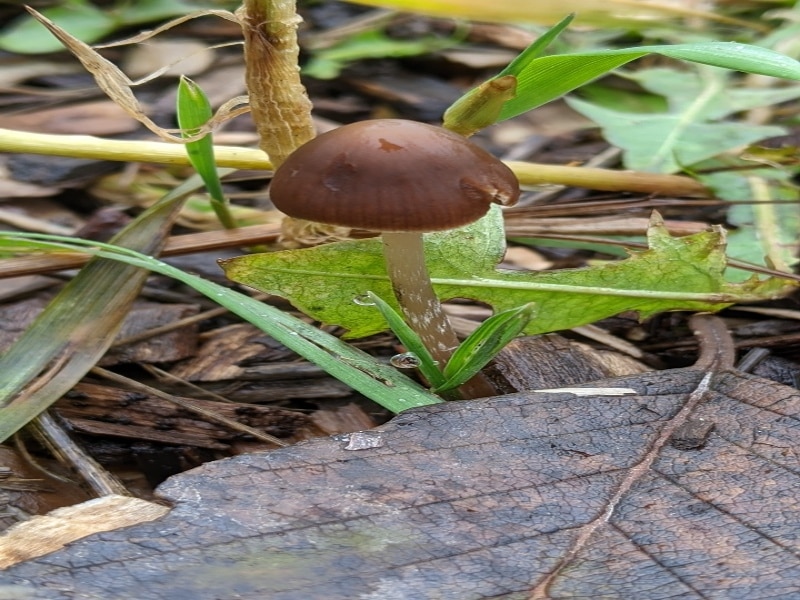
Scurfy Twiglet (Tubaria furfuracea)
The scurfy twiglet has a tawny-brown hygrophanous cap and does not have a ring around the upper stem. It grows in the same place as chip cherries, and can be confused if the chip cherry mushroom is faded or muted and does not have its distinguishable reddish color. The gills of the scurfy twiglet are brown, and the cap is often wrinkled or puckered.
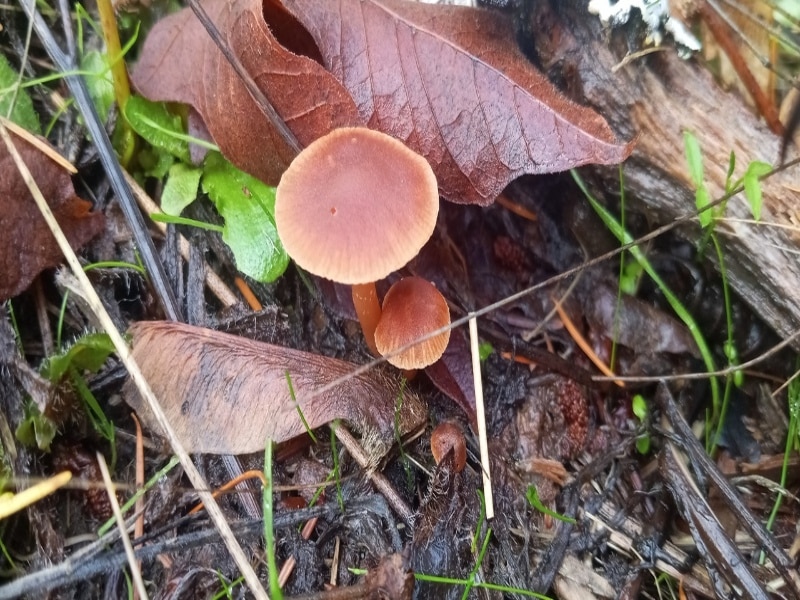
Chip Cherry Mushroom Edibility
There is no clear information about whether these mushrooms are safe to eat. Most sources say that eating chip cherry mushrooms can cause gastrointestinal distress. Many label the mushrooms as toxic. They’re not deadly, though. With all this uncertainty, we recommend not eating them.
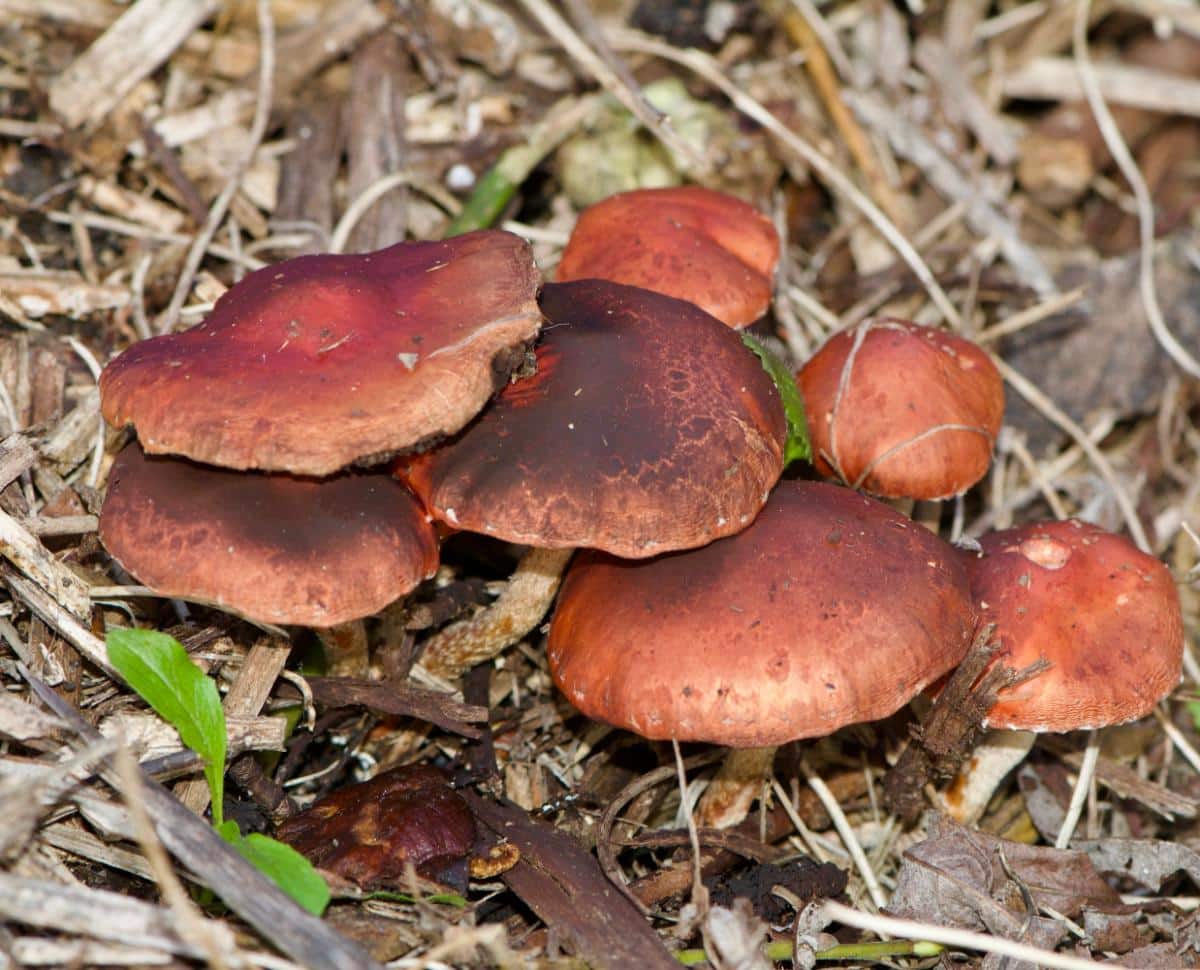
Common Questions About Chip Cherry Mushrooms
Are chip cherry mushrooms safe to eat?
Chip cherry mushrooms (Leratiomyces ceres) are generally considered inedible and potentially toxic.
When is the best time to find chip cherry mushrooms?
While chip cherry mushrooms primarily fruit from early fall through late winter, they can actually appear during any month of the year when there’s sufficient moisture. They’re particularly common in gardens and parks where wood chip mulch has been applied.
Why are chip cherry mushrooms sometimes confused with psychedelic mushrooms?
In Australia and New Zealand, chip cherry mushrooms are occasionally mistaken for psychoactive Psilocybe species due to their similar habitat preferences and appearance.
Where can chip cherry mushrooms be found globally?
It is believed that chip cherry mushrooms are native to Australia, but they have spread widely across the globe. They can now be found in Europe, North America (particularly the Pacific Northwest and, more recently, in North Carolina), New Zealand, and various other countries where wood chip mulching is common in landscaping practices.






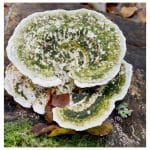
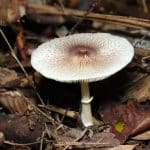

Debbie Viess says
Leratiomyces ceres are called “Larrys” in Oz as a riff off of their latin genus: Leratiomyces. Aussies are very clever with their slang! Red spies, my preferred name for ’em, are common here in California. They often grow with Psilocybe species in wood chip beds, and are MUCH easier to see than those small brown mushrooms. Hence, they SPY them out!
Jenny says
Cool, I knew there had to be a clever play on words I was missing! That is awesome, thanks for sharing — I love the name red spies too, I’m going to add that in.